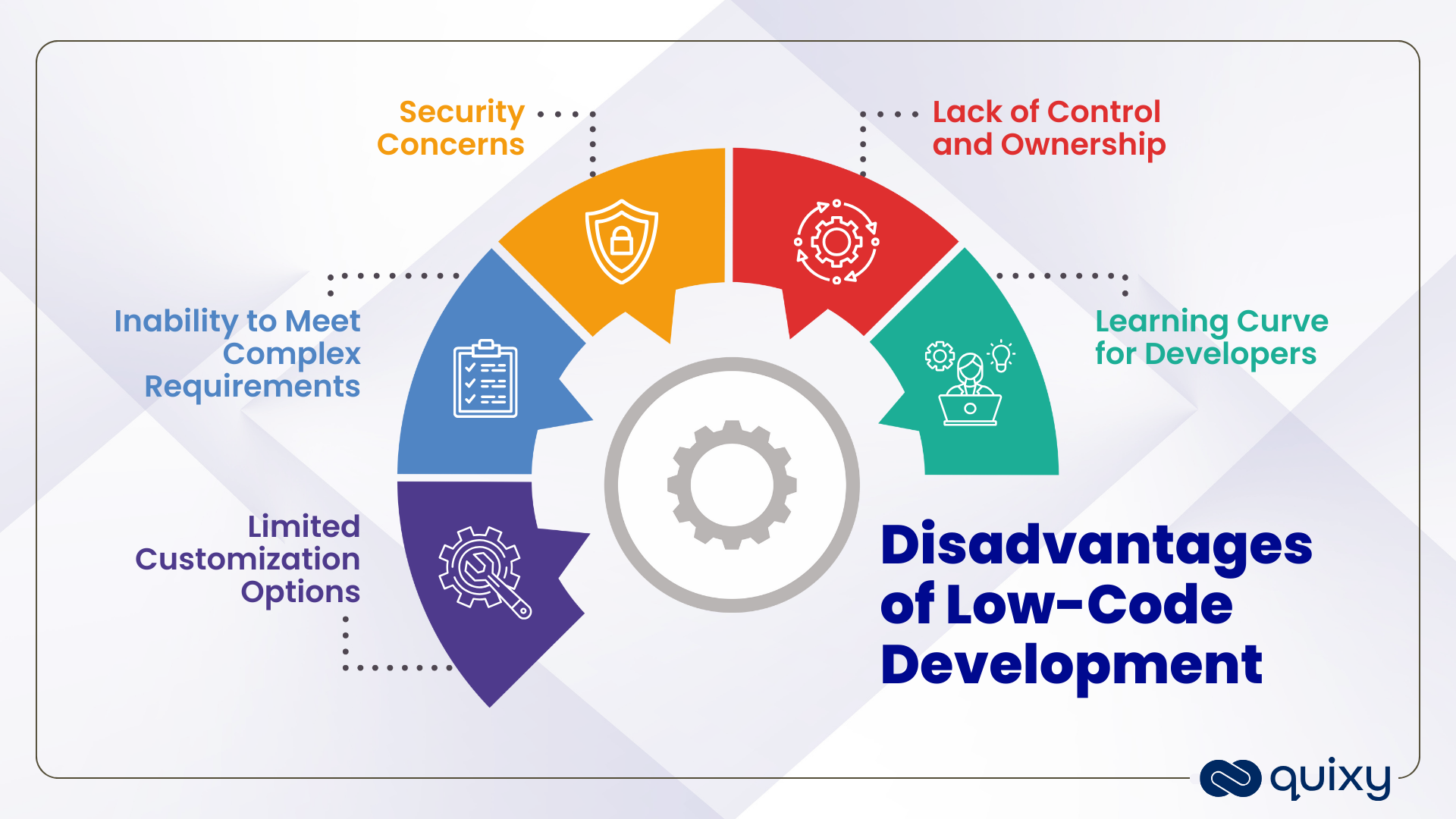
Are you intrigued by the evolution of software development and the buzz around low-code solutions? Regardless of their size, businesses grapple with a pivotal question—can low-code live up to its promise of revolutionizing innovation without demanding extensive programming skills? Does it truly offer the transformative solution it claims, or are there limitations that warrant consideration? In this blog, we will explore the intricacies of low-code development, exploring its advantages and disadvantages. As the demand for rapid application development intensifies, understanding the pros and cons of low-code development becomes imperative.
What is Low-Code Development?
Low-code development is a paradigm shift in software creation, focusing on accelerating application development by minimizing manual coding. This approach employs tools and a graphical interface, enabling developers and even non-developers to create applications visually. Complex lines of code are no longer a prerequisite; low-code platforms offer a user-friendly environment to build complete applications with modern user interfaces and rapid data integration.
The popularity of low-code development stems from its ability to streamline the development process, making it accessible to a broader audience. As businesses strive for digital transformation, the low-code approach offers a compelling alternative to traditional coding methods.
Gartner predicts that by 2026, developers outside of formal IT departments will account for at least 80% of the user base for low-code development tools, up from 60% in 2021.
Advantages of Low-Code Development

1. Increased Speed and Efficiency
Rapid Application Development
The heartbeat of low-code lies in its ability to accelerate the development cycle. Rapid application development becomes the cornerstone, allowing for swift iterations and the expedited delivery of minimum viable products (MVPs). In a digital landscape where time is a precious commodity, low-code’s prowess in hastening time-to-market stands as a compelling advantage.
Example: A marketing team needs a promotional campaign application swiftly. With low-code development, the team can create a functional prototype in a matter of days, ensuring a timely launch of the campaign.
Drag-and-Drop Functionality
At the core of low-code’s efficiency is its intuitive drag-and-drop functionality. This feature empowers developers and non-technical users alike to construct applications seamlessly. The visual interface facilitates the creation of intricate applications by assembling pre-built components, minimizing the intricacies associated with traditional coding.
Example: A business analyst with no coding background can design the user interface of a customer relationship management (CRM) tool by dragging and dropping elements onto the canvas.
Also Read: Top 13+ Benefits of Low-Code Development
2. Cost-Effectiveness
Reduction in Development Time and Resources
Low-code development emerges as a financial savant by reducing the time and resources typically expended in software development. By streamlining the coding process and offering pre-built elements, these platforms enable developers to focus on application logic and functionality, mitigating the need for laborious coding from scratch.
Example: A startup with limited resources can leverage low-code development to create a product prototype, allowing it to secure investor interest without hefty upfront development costs.
Lower Maintenance Costs
The fiscal benefits extend beyond the initial development phase. Low-code platforms contribute to lower maintenance costs over the application’s lifecycle. Streamlined development cycles and reduced complexities allow organizations to allocate resources more efficiently, ensuring a cost-effective journey from development to maintenance.
Example: A company with an enterprise resource planning (ERP) system built on a low-code platform experiences lower maintenance costs as updates and modifications are implemented seamlessly.
3. Simplified Development Process
No or Minimal Coding Knowledge Required
A revolutionary facet of low-code development is its democratization of the development process. The inclusive nature of low-code ensures that individuals with minimal coding knowledge can actively participate. This opens the gates for a broader spectrum of team members, including business analysts and subject matter experts, to contribute meaningfully to application development.
Example: An HR professional can create a leave management system without writing a single line of code, ensuring that the system aligns with the department’s unique requirements.
User-Friendly Interface
Low-code platforms are designed with a user-friendly interface and adorned with visual development tools. The simplicity of the interface empowers users to comprehend and engage with the development environment effortlessly. This intuitive design fosters a straightforward and accessible development process.
Example: A graphic designer can contribute to developing a mobile app by using a low-code platform’s user-friendly interface to design and implement the app’s visual elements.
Also Read: No-Code Vs. Low-Code: Breaking down the Pros and Cons
4. Flexibility and Scalability
Easy Customization and Modification
Flexibility emerges as a defining characteristic of low-code development, offering easy customization and modification of applications. Businesses can tailor applications to meet specific requirements without delving into extensive coding endeavors. This adaptability ensures that applications evolve seamlessly with the changing tides of business needs.
Example: An e-commerce platform can quickly customize its checkout process using low-code, adapting to changes in user preferences and industry trends without a lengthy development cycle.
Ability to Scale Applications as Needed
Scalability stands as a key advantage of low-code development. As business requirements burgeon, low-code platforms facilitate the seamless scaling of applications. Whether it’s expanding user capacity or incorporating new features, the inherent flexibility of low-code platforms supports organic business growth.
Example: A startup’s customer portal, initially designed for a limited user base, can effortlessly scale to accommodate a growing number of users without requiring a complete redevelopment.
Disadvantages of Low-Code Development

1. Limited Customization Options
Constraints of Pre-Built Templates and Components
For all its merits, low-code development comes with a trade-off in the form of limited customization options. The use of pre-built templates and components may impose restrictions on the depth of customization possible. Businesses with intricate needs might find themselves constrained within the boundaries set by low-code platforms.
Example: A project requiring highly specialized and unique visual elements may face challenges as the low-code platform’s pre-built components might not fully align with the desired design.
Inability to Meet Complex Requirements
Projects with complex and highly specific requirements may find low-code development falling short. The emphasis on speed and simplicity might compromise the ability to meet the intricate demands of certain applications. The one-size-fits-all approach may not align with projects requiring a bespoke touch.
Example: Developing a comprehensive healthcare management system with intricate data-sharing requirements may exceed the capabilities of some low-code platforms.
Also Read: 10+ Low-Code Use Cases
2. Security Concerns
Vulnerabilities Associated with Third-Party Components
Security takes center stage as a paramount concern in low-code development. The reliance on various third-party components introduces potential vulnerabilities that demand meticulous assessment and mitigation. Businesses must navigate the delicate balance between speed and security, ensuring robust protection against potential threats.
Example: Integrating a third-party authentication module may introduce security vulnerabilities if not thoroughly vetted, potentially exposing sensitive user data to unauthorized access.
Potential for Data Breaches
The potential for data breaches is heightened in low-code development, particularly if security protocols are not rigorously adhered to. Businesses must maintain vigilant guardianship over data protection, ensuring that applications developed on low-code platforms adhere to stringent security measures.
Example: A financial application built on a low-code platform may face data breach risks if encryption standards and access controls are not diligently implemented.
3. Lack of Control and Ownership
Dependency on Low-Code Platform Providers
A substantial drawback of low-code development lies in its dependency on platform providers. Businesses may find themselves tethered to the policies and decisions of their chosen platform provider, raising concerns about control and ownership of the applications developed. This dependency introduces an element of uncertainty into the long-term management of applications.
Example: A company relying on a specific low-code platform may face challenges if the platform provider introduces pricing changes or discontinues support for certain features.
Restrictions on Code Access and Modification
Low-code platforms often restrict access to the underlying code, limiting the ability to make granular modifications. This lack of access may pose challenges if businesses decide to switch platforms or if the chosen platform undergoes significant changes. The restricted access challenges the traditional notion of complete control over the application code.
Example: A business wanting to migrate its application to a different low-code platform may encounter obstacles if the current platform restricts access to the application’s source code.
Also Read: What are the Top 8 Features of Low-Code Platforms?
4. Learning Curve for Developers
Need for Understanding the Low-Code Platform and Its Limitations
Despite the aspiration to simplify the development process, low-code platforms introduce a learning curve for developers. Understanding the intricacies of the platform and its limitations becomes crucial for effective application development. Developers accustomed to traditional coding practices may need to invest time in adapting to the visual and drag-and-drop nature of low-code development.
Example: A seasoned developer may need time to become proficient in using a low-code platform’s visual interface and understanding its capabilities and constraints.
Potential Skill Gap for Handling Specific Requirements
In scenarios where applications require specialized functionalities or intricate coding, a skill gap may emerge among developers using low-code platforms. Bridging this gap may necessitate additional training or, in certain cases, reverting to traditional coding methods to meet the project’s specific requirements.
Example: Developing a machine learning algorithm within a low-code environment may require developers to acquire additional skills in machine learning, potentially leading to a gap in expertise.
Also Read: 10-Step Guide On How to Choose The Right Low-Code Development Platform
Conclusion
In conclusion, the advantages and disadvantages of low-code development present a nuanced landscape for businesses to navigate. The speed, cost-effectiveness, and democratization of development offered by low-code platforms are undeniably attractive. However, businesses must weigh these benefits against potential limitations, especially in customization, security, and control.
Consideration of use cases is paramount when deciding whether to embrace low-code development. Low-code development proves particularly effective for internal tools, customer-facing applications, and small to medium-sized projects. However, a traditional development approach might be more suitable for projects with intricate requirements or a need for extensive customization.
As organizations navigate the software development landscape, understanding the layers of advantages and disadvantages ensures informed decision-making. With its transformative impact, low-code development becomes a powerful tool when wielded with a clear understanding of its implications.
Frequently Asked Questions (FAQs)
Q. What are the pros and cons of low-code development?
Pros: Accelerated development, cost-effectiveness, simplified process, and flexibility.
Cons: Limited customization, security concerns, potential lack of control, and a learning curve for developers.
Q. Why is low-code development important?
Low-code development is crucial for its ability to accelerate application development, reduce costs, democratize the process, and adapt quickly to changing business needs.
Q. What are the drawbacks of a coding platform?
The drawbacks of coding platforms may include longer development times, higher costs, the need for specialized coding skills, and challenges in adapting to evolving requirements.
Q. What is the difference between low-code and No-Code App builders?
The main difference lies in user involvement. Low-code involves minimal coding, while No-Code requires no coding at all, catering to users with varying technical expertise.
Q. What is low code software development?
Low-code software development is an approach that minimizes manual coding, utilizing visual interfaces and pre-built components to accelerate the application development process.
Q. How do low-code platforms help businesses democratize and accelerate innovation?
Low-code platforms enable individuals with minimal coding knowledge to actively participate in development, democratizing the process. They also accelerate innovation by hastening development cycles and reducing resource-intensive tasks.
Login
Please login to comment
0 Comments
Oldest















